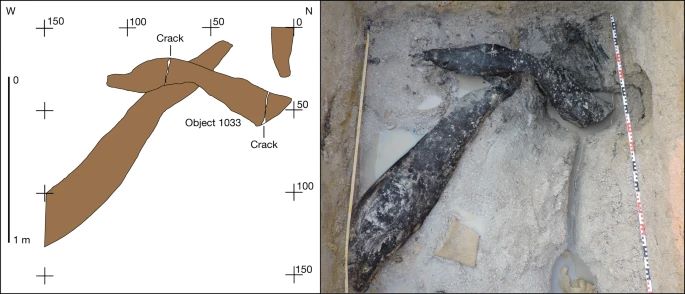The world’s oldest wooden structure discovered in Zambia
A joint team from the University of Liverpool and Aberystwyth University, both in the United Kingdom, has discovered that almost half a million years ago, far earlier than previously believed, humans were already constructing wooden structures.

Site location in Zambia. Credit: Nature
The research, published in the journal Nature and explained in a press release, says that the archeologists found well-preserved wood with signs of deliberate crafting work during excavation at the archaeological site of Kalambo Falls, Zambia. The artifacts date back at least 476,000 years and predate the emergence of our own species, Homo sapiens.
What sets this discovery apart is the expert examination of stone tool cut-marks on the wood, providing clear evidence that early humans from this era had the ingenuity to shape and assemble two sizable logs, presumably to create the foundation of a platform or a section of a dwelling.
More to read:
Human ancestors were almost extinct 900,000 years ago
This marks the earliest evidence globally of humans deliberately crafting and fitting together wooden logs. Until now, the primary evidence of wood usage by early humans was limited to its application in fire-making, crafting digging sticks, and fashioning spears.

The wooden structure near Kalambo Falls.
Credit: Nature
The rarity of wood preservation in ancient archaeological sites is mainly due to its susceptibility to rot and deterioration. Fortunately, the wood was preserved because Kalambo Falls kept the pieces permanently waterlogged, hence sealing them away from oxygen and oxygen-dependant bacteria that would degrade them and allowing us to seize an ultra-rare opportunity to glimpse into our distant past.
At the same location, the scientists also found four tools from wood: a digging stick, a cut log, a wedge, and notched branch, each also dating to before the time of modern humans.
This groundbreaking find challenges the prevailing perception that Stone Age humans were exclusively nomadic. At Kalambo Falls, these early humans not only enjoyed a continuous water source but also had access to sufficient forest resources for sustenance and shelter. The wooden structure is a proof that they were settled there for a long time.

Left - Kalambo Falls. Right - Archeologists working at the site. Credit: Eurekalert
Professor Larry Barham, from the University of Liverpool’s Department of Archaeology, Classics and Egyptology, who leads the ‘Deep Roots of Humanity’ research, has changed his opinion about our early ancestors.
“Forget the label ‘Stone Age,’ look at what these people were doing: they made something new, and large, from wood. They used their intelligence, imagination, and skills to create something they’d never seen before, something that had never previously existed. They transformed their surroundings to make life easier, even if it was only by making a platform to sit on by the river to do their daily chores. These folks were more like us than we thought,” he said.
The specialist dating of the finds was undertaken by experts at Aberystwyth University, who used new luminescence dating techniques to reveal the last time minerals in the sand surrounding the finds were exposed to sunlight, in order to determine their age.
The site at Kalambo Falls had been excavated back in the 1960s when similar pieces of wood were recovered, but not dated, therefore the true significance of the site was unclear until last September.
More to read:
New clues why Neanderthals lost to modern humans
This research forms part of the pioneering ‘Deep Roots of Humanity’ project, an investigation into how human technology developed in the Stone Age. The project is funded by the UK’s Arts and Humanities Research Council and involved teams from Zambia’s National Heritage Conservation Commission, Livingstone Museum, Moto Moto Museum and the National Museum, Lusaka.
The site of Kalambo Falls on the Kalambo River lies above a 235 meters waterfall on the border of Zambia with Tanzania, at the edge of Lake Tanganyika. The area has been proposed to become a UNESCO World Heritage site thanks to its archaeological significance.
***
Feel free to support our small office: IBAN - RO50BTRLEURCRT0490900501, Swift - BTRLRO22, Beneficiary - Rudeana SRL.
Not feeling like donating? Then click on banners on our website to generate ad revenue. Any help is welcome.







